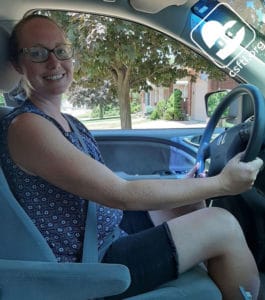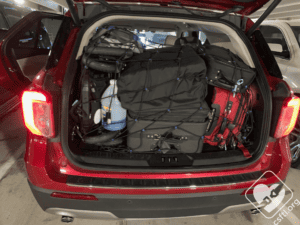You’ve prepared your vehicle and double-checked the car seats. Your bags are packed and safely secured. Are you ready to hit the road?
Planning a road trip with littles in tow can be a daunting task. The unfortunate reality is that getting from point A to point B will take longer than it did in those easy-breezy pre-kid days.
Caregivers in our Facebook group have plenty of questions about the recommendation to stop frequently on road trips. As fellow caregivers, we can empathize with wanting to reach the destination quickly.
Some drivers boast about traveling for hours on end, stopping only to fill the gas tank once the light comes on. They may drive overnight, expecting to reduce (or even eliminate) the need for stops as children sleep peacefully in their car seats. This method is convenient but risky.
The Risks
Survivorship bias might falsely convince us that the marathon approach is safe and convenient. Driving many hours without breaks isn’t a flex. In fact, it can endanger both the driver and their passengers.
The Driver: Maintaining Attention

Awake driver, ready to drive safely!
The Occupational Safety and Health Administration (OSHA) advises drivers to make frequent stops on a road trip: “Stop at regular intervals when driving long distances. Get out of the car every 2 hours to stretch and walk briskly” (2005, p. 32). Driving requires full attention, and maintaining that level of alertness is nearly impossible without breaks.
Frequent stops also reduce the risk of drowsy driving, which can be as dangerous as driving while intoxicated.
Everyone: Avoiding Blood Clots
Traveling for four hours or more increases the risk for developing blood clots. This risk is generally small, but increased risk factors include pregnancy, recent surgery, the postpartum period, and the use of estrogen-containing contraceptives. Many caregivers fit into one or more of these categories of increased risk.
The Centers for Disease Control (CDC) recommends that travelers take movement breaks: “Move your legs frequently when on long trips and exercise your calf muscles to improve the flow of blood” (2023). Plan for frequent rest stops to stretch your legs so that you’re not sitting for prolonged periods.
Young Passengers: Oxygen Desaturation
Hemoglobin in red blood cells carries oxygen from the lungs to tissues throughout the body. Normal oxygen saturation is typically considered 95% or greater. Spending long periods in a car seat can increase the risk of hypoxia (low oxygen in body tissues).
Preterm and low birthweight babies are especially at risk, but even healthy full-term newborns can experience worrisome oxygen desaturation episodes in the car seat (Kornhauser Cerar et al., 2009). If you’re traveling with a young baby, it’s important to stop frequently and remove them from the car seat.
Young Passengers: Positional Asphyxiation
Along with oxygen desaturation, young infants are at risk for positional asphyxiation; this occurs when body positioning interferes with breathing. Of the deaths in car seats that were reported to the US Consumer Products Safety Commission (unrelated to vehicle crashes) between April 2004 and December 2008, 48% were the result of positional asphyxia (Batra et al., 2015).
Unfortunately, the majority of car seats are used incorrectly, and those rates of misuse may be even higher with newborns (Hoffman et al., 2016). Seek help from a CPST; installing the car seat at the correct angle and harnessing properly can both reduce the risk of positional asphyxiation.
Fortunately, the risk of positional asphyxiation diminishes as babies grow and develop the head/neck strength to reposition themselves.
The Reality of Road Trips with Kids
For many caregivers, planning these “extra” stops is unnecessary. The inherent chaos of roadtripping with kids naturally takes care of that for us.
Caregivers often need unplanned breaks for diaper changes, bottle feeding or nursing, spills, car sickness, screaming toddlers, or hunting down that lost pacifier. Older children (and adults) will inevitably need a bathroom break.
Stop Frequently
Our mission at CSFTL is to empower caregivers to keep children safe. If, by some miracle, you reach that magical road trip phase where everyone stays content and occupied for hours, it’s still important to stop often. The American Academy of Pediatrics (AAP) advises to “Plan to stop driving and give yourself and your child a break about every two hours” (2018).
Stretch your legs, grab your preferred convenience store snack, and (try to) enjoy the journey. We hope your destination is well worth the wait.
References
American Academy of Pediatrics. (2018, August 30). Travel safety tips. Healthy Children. https://www.healthychildren.org/English/safety-prevention/on-the-go/Pages/Travel-Safety-Tips.aspx
Batra, E. K., Midgett, J. D., & Moon, R. Y. (2015). Hazards associated with sitting and carrying devices for children two years and younger. The Journal of Pediatrics, 167(1), 183–187. https://doi.org/10.1016/j.jpeds.2015.03.044
Centers for Disease Control and Prevention. (2023, June 28). Blood clots and travel: What you need to know. https://www.cdc.gov/ncbddd/dvt/travel.html
Hoffman, B. D., Gallardo, A. R., & Carlson, K. F. (2016). Unsafe from the start: Serious misuse of car safety seats at newborn discharge. The Journal of Pediatrics, 171, 48–54. https://doi.org/10.1016/j.jpeds.2015.11.047
Kornhauser Cerar, L., Scirica, C. V., Gantar, I. S., Osredkar, D., Neubauer, D., & Kinane, T. B. (2009). A comparison of respiratory patterns in healthy term infants placed in car safety seats and beds. Pediatrics, 124(3), e396-e402. https://doi.org/10.1542/peds.2009-0160
Occupational Safety and Health Administration. (2005). Guidelines for employers to reduce motor vehicle crashes. https://www.osha.gov/sites/default/files/publications/motor_vehicle_guide.pdf



